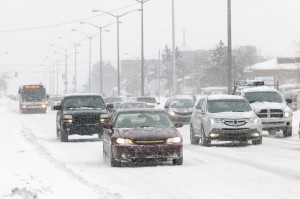 If you live in Michigan, wintry weather and snow are a part of life. Not only are residents required to keep their sidewalks and mailboxes free of snow and ice buildup, but drivers are also required to follow Michigan automobile snow removal laws.
If you live in Michigan, wintry weather and snow are a part of life. Not only are residents required to keep their sidewalks and mailboxes free of snow and ice buildup, but drivers are also required to follow Michigan automobile snow removal laws.
Do Michigan automobile snow removal laws require brushing off my windshield and other windows?
Yes. According to Michigan automobile snow removal laws, specifically MCL 257.709 of the Michigan Vehicle Code, drivers may not operate their vehicles when there is an object that impairs the driver’s vision.
In addition, a driver may not operate a motor vehicle if rear-window visibility is obstructed, unless the vehicle has two side mirrors that are adjusted to provide a clear view of the road behind the vehicle.
Must I remove snow and ice from my vehicle’s tail lights or headlamps?
Yes. In Michigan, tail lights, rear lamps and headlamps are supposed to be a certain brightness and should be seen from a certain distance. It is illegal for obstructions like snow and ice to interfere with these brightness requirements.
MCL 257.699 says that headlamps must emit a white light, while auxiliary lamps may emit either a white or amber light. The statute also says:
- “There shall be an uppermost distribution of light, or composite beam, so aimed and of an intensity as to reveal persons and vehicles at a distance of at least 350 feet ahead for all conditions of loading.”
- “There shall be a lowermost distribution of light, or composite beam, so aimed and of sufficient intensity to reveal persons and vehicles at a distance of at least 100 feet ahead; and under any condition of loading none of the high intensity portion of the beam shall be directed to strike the eyes of an approaching driver.”
Rear lamps are governed by MCL 257.686, which says:
- “Either a tail lamp or a separate lamp shall be constructed and placed so as to illuminate with a white light the rear registration plate and render it clearly legible from a distance of 50 feet to the rear. A tail lamp or tail lamps, together with any separate lamp for illuminating the rear registration plate, shall be wired so as to be lighted whenever the head lamps or auxiliary driving lamps are lighted.”
MCL 257.697 discusses signal lamps on the rear of a vehicle and provides:
- “A stop lamp shall be capable of being seen and distinguished from a distance of 100 feet to the rear both during normal sunlight and at nighttime and a signal lamp or lamps indicating intention to turn shall be capable of being seen and distinguished during daytime and nighttime from a distance of 100 feet both to the front and rear. When a vehicle is equipped with a stop lamp or other signal lamps, the lamp or lamps shall at all times be maintained in good working condition.”
What if snow falls off my vehicle while I’m driving?
We’ve all seen it happen while traveling down the highway: a sheet of snow and/or ice suddenly falls from the roof of a nearby vehicle, sometimes hitting or nearly missing your vehicle or someone else’s car. When this happens with semi-trucks or other large vehicles, it can be especially dangerous.
Under MCL 257.677a(2)-(4), it is illegal for snow, ice or slush to fall into either the roadway or the shoulder in such a way that a motorist’s vision is impaired. The statute says a person shall not:
- “remove, or cause to be removed, snow, ice, or slush onto or across a roadway or the shoulder of the roadway in a manner which obstructs the safety vision of the driver of a motor vehicle other than off-road vehicles.”
- “deposit, or cause to be deposited, snow, ice, or slush onto or across a roadway or the shoulder of the roadway in a manner which obstructs the safety vision of the driver of a motor vehicle.”
- “deposit, or cause to be deposited, snow, ice or slush on any roadway or highway.”
What it boils down to is this: remove the snow and ice from your vehicle before driving. Make sure there is nothing on your vehicle that may reduce your visibility. Make sure there are no chunks of snow, ice or slush on your vehicle, which can easily become a hazard if they fly off your vehicle, causing an auto accident and injury to you … or someone else.
What happens if I do not follow Michigan automobile snow removal laws?
If you drive a vehicle in the snow without adhering to the laws, you can be pulled over and ticketed by law enforcement. So, to avoid a citation and an encounter with police the next time you’re driving in Michigan’s wintry weather, remember to remove the ice and snow from your vehicle.
If you’re injured in an accident involving snow or ice, or if you have questions about your legal obligations in a car crash, contact one of our Lansing auto accident attorneys or Grand Rapids car accident lawyers for a free personal injury consultation.
